In this series we cover the rise of Islamic Spain or Al-Andalus followed by the gradual reconquest of Spain by the Spanish Christian Kingdoms.
We take a look at the Iberian peninsular from Roman rule to the establishment of the Visigoths.
We examine the lead up to the battle of 711 and the final years of Visigothic rule.
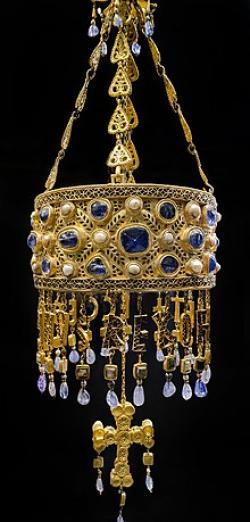
We discuss the Battle of 711, which brought the Muslim conquerers to the Iberian peninsula.
Following the Muslim victory, someone hid the treasures of the Visigothic Kings at a place called Guerrazar, near Toledo. The hiding place was so effective that the treasure remained hidden for over 1000 years. Thankfully it was rediscovered in 1858 and pieces of the find are now on display in Paris and Madrid.
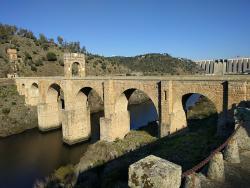
We explore how the Muslim invaders were able to consolidate their hold on the Iberian peninsula.
One of the reasons why the Muslim invaders were ultimately successful, was the raft of Roman infrastructure already in place across the peninsula. One stunning example of this is the Alcantara Bridge. Already over 600 years old at the time of the Muslim invasion, it is still standing today - nearly 2000 years after it was constructed.
The Muslim rulers of Al-Andalus put down a Berber uprising, only to face some bigger problems caused by some troublesome newcomers.
The last surviving member of the Umayyad dynasty makes his way to al-Andalus.
Abd al-Rahman died in 788. Which one of his three sons will succeed him?
We cover the lengthy reign of al-Hakam then journey to the northern coast of the Iberian Peninsula where some independent Christian states are beginning to emerge.
We take a look at the creation of the tiny rebel Christian Kingdom of Asturias.
We take a look at the Iberian peninsula after 100 or so years of Muslim rule.
We take up the narrative in the year 822 and welcome a new Emir to the stage, Abd al-Rahman II, who faces a new threat in the form of the Vikings.
We take a look at the effect of the colourful reign of Abd al-Rahman II on the Christians of al-Andalus

We see how Christians who left al-Andalus for the northern Christian regions during the rule of Abd al-Rahman II affected the places they settled in. We also take a closer look at the Basque region.
One example of Arabic culture being transferred from al-Andalus to the north, comes in the form of illustrations by Magius, a Christian artist who left Cordoba and settled in the Kingdom of Asturias. The pictures he drew for a copy of a manuscript by Beatus of Liebana depict clear Arabic influences.
The rule of Abd al-Rahman II comes to an end and we welcome a new Emir to al-Andalus.
While the Emir of al-Andalus Muhammad I is busy trying to control the rebellions breaking out across his territory, a new threat emerges in the form of King Alphonso III of Asturias.
While King Alfonso III of Asturias continues his programme of expansion in the north of the Iberian peninsula, a new rebel leader emerges to the south of Cordoba.
The new Emir Abd-Allah begins his lengthy and disastrous period of rule in al-Andalus.
Abd al-Rahman III orders construction to commence on an enormous new palace complex near Cordoba.
Abd al-Rahman III continues his wildly successful period of rule.
We take a look at the influence of the respected Jewish scholar Hasdai ibn Shaprut and see how al-Hakam II fared as the new Caliph of al-Andalus.
When al-Hakam II suffers a downturn in his health, an ambitious palace official senses an opportunity.
With the Caliphate in a vulnerable state, al-Mansur plots his own rise to power.
Having taken control of the adminstration of al-Andalus, al-Mansur turns his attention to the Caliphate's military forces, a move which will bring him into direct conflict with his father-in-law Ghalib.
Al-Mansur reaches the height of his power and celebrates by launching an attack against the heart of the Christian north - the sacred site of Santiago de Compostela.
We examine the legacy of the twenty year long period of rule by al-Mansur following his death in 1002. Will his son and successor Abd al-Malik be able to rule the Caliphate as effectively as his father?
We take a look at the short but disastrous rule of the latest person to rule al-Andalus on behalf of the Caliph, Sanchuelo.
The Caliphate stumbles from crisis to crisis before collapsing completely, while the Caliph Hisham II makes a surprise return.
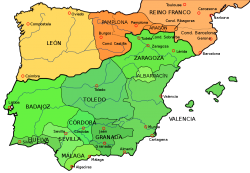
We track developments in the Kingdom of Navarre, up until the end of the Caliphate.
King Sancho III of Navarre (aka Sancho el Major or Sancho the Great) was responible for extending the borders of his tiny Kingdom across the Christian North, over the Pyrenees into modern day France and down to Barcelona on the Mediterranean coast. His sucesses will pave the way for the establishment of the kingdom of Aragon and the Kingdom of Castile.
We continue our examination of the Christian states by taking a look at Catalonia and the emerging Kingdom of Aragon.
We take a look at the Christian north, at the time of the fall of the Caliphate.
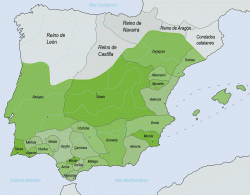
Following the collapse of the Caliphate, a number of regional kingdoms or Taifas, emerged to fill the power vacuum
A new power-figure is emerging on the Iberian peninsula, in the form of King Fernando I of Leon and Castile.
We follow the successful reign of King Fernando I until his death in 1065.
Following the death of King Fernando I of Leon and Castile, his heirs clash in an epic succession battle.
We move over to the Pyrenees to find the Kingdom of Aragon attempting to extend its territry into Muslim Zaragoza
Amies from France and beyond fail to permanently conquer territory inside the taifa of Zaragoza.
During the 1070s, two assassinations - one in al-Andalus and one in the Christian north - send shockwaves across the Iberian peninsula.
The taifa of Toledo hits a rough patch which King Alfonso VI manipulates to his advantage. Meanwhile, Rodrigo Diaz de Vivar (later known as El Cid) makes a couple of poor choices and ends up in exile.
In the first major victory of the Reconquista, Toledo falls to King Alfonso VI.
As King Alfonso turns his attention to the east of al-Andalus, different factions inside Toledo struggle for power.
As King Alfonso VI and Rodrigo Diaz de Vivar prepare to face off at the siege of Zaragoza, a new threat emerges to the south.
The Almoravids arrive in al-Andalus and clash with King Alfonso VI at the battle of Sagrajas in October 1086.
Between the departure of the Almoravids and their return in 1089, a number of significant events take place.
We examine events which take place between the departure of the Almoravids in 1088 and their return in 1090.
The Almoravids arrive in al-Andalus in 1080 and begin to conquer the taifas.
Rodrigo Diaz de Vivar (aka El Cid) scores a memorable victory against the Almoravids at the battle of Cuarte in 1094.
The Kingdom of Leon and Castile and the Christian terriitory of Valencia both grapple with succession issues.
While King Alfonso VI continues to face succession issues, a shift in popular consciousness begins to take place following the death of El Cid.
Just when King Alfonso VI believes he has finally resolved his succession issues, an unexpected event throws all his plans into chaos.
The marriage of Alfonso I of Aragon to Urraca of Leon and Castile gets off to a rocky, gravelly and croaky start - just like my voice in this episode!
Following the breakdown of the marriage between Queen Urraca and Alfonso of Aragon, family rivalries threaten to destabilise the Kingdom of Leon and Castile.
King Alfonso of Aragon and Queen Urraca finally decide to set their differences aside and keep the peace.
The Kingdom of Portugal emerges, while Queen Urraca endures one of the worst days of her reign in Santiago de Compostela.
King Alfonso of Aragon embarks on an ambitious campaign to conquer Zaragoza in 1118.
With King Alfonso occupied in Zaragoza, Queen Uracca moves against her enemies in the north of the peninsula.
Queen Urraca finds herself in conflict with Rome following her imprisonment of Archbishop Gelmirez of Santiago de Compostela in 1120.
We check in on Alfonso of Aragon who is attempting to secure the taifa of Zaragoza
Fresh from his victory over Zaragoza, Alfonso of Aragon embarks on an ambitious campaign deep into Almoravid territory in 1125.
The death of Queen Urraca in 1127 results in a scramble for power in the north of the peninsula.
In an unexpected turn of events, King Alfonso of Aragon finds himself bogged down by events in France.
Alfonso of Aragon dies in 1134. However, the terms of his will leave the Kingdom of Aragon facing an uncertain future.
Fall out from the death of Alfonso of Aragon and his creative succession plans leaves leaders from across the region scrambling to take advantage of the situation.
The Kingdom of Aragon struggles to survive as the succession drama following the death of Alfonso of Aragon continues.
We see the succession drama following the death of Alfonso of Aragon finally come to an end, with the Christian portion of the Iberian peninsula forming itself into four kingdoms - the Kingdom of Leon & Castile, the Kingdom of Aragon/Catalonia, the Kingdom of Navarre and the Kingdom of Portugal.
We switch our focus to the southern portion of the Iberian peninsula, where the Almoravids are struggling to hold onto power.
As Almoravid rule collapses across northern Africa and al-Andalus, the Almohads prepare to move in.
As armies across Europe begin mobilising for the Second Crusade, King Alfonso I of Portugal decides to use some crusaders in his upcoming attack on Lisbon.
The fleet of crusader ships sails southwards for talks with King Alfonso I of Portugal regarding the siege of Lisbon.
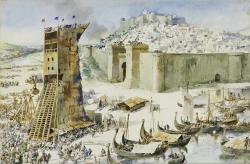
The siege of Lisbon begins with an attack on the suburbs followed by the construction of some impressive siege equipment.
This painting by Roque Gameiro shows the Anglo-Norman siege tower approaching the corner tower of the Lisbon walls.
The siege of Lisbon ends with the surrender of the city to the Kingdom of Portugal.
While the King of Portugal has been besieging Lisbon, King Alfonso VII and the Count of Barcelona have been conquering Muslim territory in the south of the peninsula.
King Alfonso VII's attempts to conquer al-Andalus hit a roadblock, causing him to rethink his strategies.
Just as the Almohads begin to go on the offensive, King Alfonso VII becomes seriously ill.
Following the fateful decision by the late King Alfonso VII to split his kingdom in two, we meet the new kings on the block - King Sancho III of Castile and King Fernando II of Leon.
Some unexpected deaths result in two of the kingdoms of Christian Spain being ruled by children named Alfonso. Meanwhile, the Almohads are also on the back foot, as the Caliph and his army become distracted by events in northern Africa.
Plans by the Almohads to dominate al-Andalus are interrupted by the death of the Caliph.
As the new Caliph settles into his role, he turns his attention to al-Andalus, focussing on two main threats - the Wolf King and a Portugese freelancer named Geraldo the Fearless
The Almohads finally achieve their goal, becoming the uncontested rulers of al-Andalus.
In 1172, the Caliph embarks on an ambitious campaign to conquer Christian Spain
We continue to the follow the Caliph on his less than optimal military campaign.
We track the progress of two new young kings - King Alfonso VIII of Castile and King Alfonso II of Aragon.
The Caliph launches his campaign against the Christians in 1184 and we wave goodbye to three main players in our narrative.
Following the bunch of deaths which occurred in the last episode, we have a bunch of new kings in Christian Spain - most of whom are named Alfonso.
During the years 1190 and 1191, the Caliph launches a number of attacks on the Kingdom of Portugal, intent on reclaiming the town of Silves.
The truces between the Christian rulers and the Caliph expire and both sides clash once again, culminating in the Battle of Alarcos in 1195.
Following its defeat at the Battle of Alarcos, the Kingdom of Castile faces an existential threat in 1196 as it is attacked simultaneously by Leon, Navarre and the Almohads.
A decade long period of peace commences between the Christians and the Muslims on the Iberian peninsula, leaving the Christian kings free to fight each other.
Following a decade-long period of peace, the Christians and Muslims of the Iberian peninsula clash once again, with the Caliph targetting the Christian stronghold of Salvatierra.
It's time for a crusade! A major crusading expedition departs from Toledo in June 1212, intent on confronting the Caliph.

We conclude our look at the battle of Las Navas de Tolosa which ends in a decisive victory for the crusaders.
The ornate tapestry which adorned the entrance to the tent belonging to Caliph al-Nasir was seized as one of the spoils of the battle. You can view the tapestry in person at the monastery of Huelgas in Burgos, in Spain.
A bunch of deaths in the years following the battle of Las Navas de Tolosa leave a lasting impact on the politics of the Iberian peninsula.
We welcome a new King to the throne of Castile and join the Portugese on a crusade to take a fortress to the south of Lisbon.
As crusading fever sweeps across Europe, a number of crusades are launched against the Almohads - with mixed results.
Young King Fernando III of Castile embarks on his first crusade, while one of the contenders for Caliph forms an unlikely alliance with Castile.
As Caliphs come and go at a dizzying rate, Almohad rule in al-Andalus crumbles.
We follow King James I of Aragon and King Alfonso IX of Leon as they go on the offensive.
As the Muslims of al-Andalus focus on fighting each other, King Fernando of Leon and Castile races to take advantage of an opportunity to attack Cordoba.
The Christians succeed in taking one of the most important cities in al-Andalus - the city of Cordoba which surrendered in 1236.